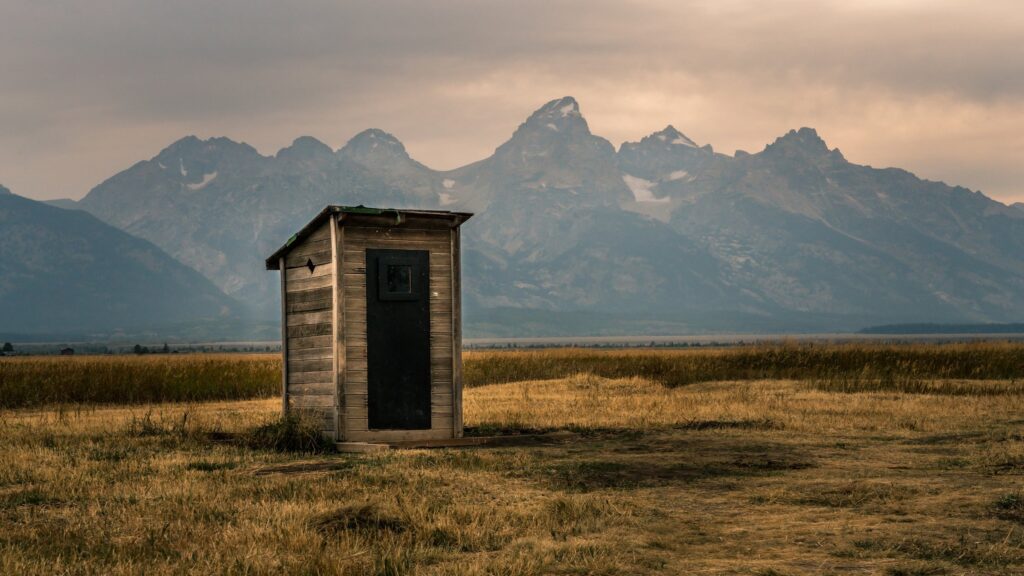The area around a popular lake trail is replete with human waste. Park officials may install a permanent toilet.
Outhouse in front of the Grand Tetons. Andrew James Photo/Getty Images
Updated August 27, 2025 02:09PM
Wyoming’s Grand Teton National Park is dealing with an overload of human poop in wilderness areas, and park officials are considering installing a permanent toilet in at least one backcountry area to deal with the problem.
That’s the focus of a recent report in the Jackson Hole News & Guide.
A 2022 park study found high quantities of human feces around Taggart Lake, one of the park’s most popular destinations, according to the News & Guide. During five visits, combing areas less than 100 feet away from the trail, park rangers and trail crews “found human waste, toilet paper or hygiene products 73 times.”
For obvious reasons, no one wants to see (or smell) excrement when hiking in a beautiful natural location. But excess quantities of feces also pose serious health concerns. Human excrement can contain a wide range of parasites, bacteria, and viruses that can contaminate bodies of water, causing harm not only to humans but also to flora and fauna.
Unfortunately, in popular, high-traffic wilderness destinations like Grand Teton National Park, many visitors are unaware of proper outdoor etiquette for disposing of human waste. They don’t bury it deep enough, or far enough away, or they don’t bury it at all.
The problem has led numerous trails and outdoor destinations across the West to install toilets and offer WAG bags.
“For most of our visitors, it’s their first time here,” Sami Powers, a staffer who manages the park’s environmental compliance program, told Jackson Hole News & Guide. “They’re not super familiar with being in the backcountry.”
“Sometimes you can tell if it was an emergency or if they planned it by whether there’s clothing there,” she added.
Even if all visitors properly dispose of bodily waste following Leave No Trace standards—in a cathole six to eight inches deep and at least 200 feet from trails, campsites, and bodies of water—in areas with extremely high visitation, excrement will eventually reach a critical mass.
Last fall, researchers from the Environmental Protection Agency revealed that another lake in a remote region of Wyoming’s Wind River Range was heavily contaminated with human feces—over 384 times higher than the recommended limit for safe swimming.
As gross as it is, the overload of human feces at Lake Taggart isn’t surprising. During the study period, which lasted from mid-July to mid-September, over 40,000 people visited the area.
The park service has taken several steps to reduce waste, including signage at trailheads that informs visitors the backcountry is a “toilet-free zone.” They’ve also increased the promotion of WAG bags—disposable bags that allow hikers to pack their own feces out of the backcountry.
Cathy Shill, the owner and founder of tour company Hole Hiking Experience, told the Jackson Hole News & Guide that in her experience, messaging alone isn’t enough.
“People don’t really read signs,” she said. “I don’t think a sign resonates.”
A 2025 environmental assessment of Taggart Lake found that outdated facilities are also a contributing factor. Park officials are now considering other options, such as installing a pit toilet near Taggart Lake. The proposed plan would also include a water station, additional toilets at the trailhead, a larger parking lot, and trail improvements. The park opened the issue to public comment on August 20 and is accepting input through September 23.
“We don’t really have any preconceived notions of what we’re going to do,” Powers said, noting that if public feedback was negative, the backcountry toilet may not be installed.
Although the Taggart Lake trail is a popular area, Powers clarified that the poop there isn’t necessarily any worse than elsewhere in the park. Officials just decided to trial the plan at Taggart to see if it would have a positive impact. “It was something else we could look at while we were doing the rest of the project,” Powers said.
According to the environmental assessment posted by the park service, the backcountry toilet would be installed only if “other actions to reduce human waste around Taggart Lake, including visitor education programs” fail. The proposed toilet would have up to two stalls and be 16 by 10 feet in size, surrounded by a leach field of roughly 200 square feet. Once installed, facilities would be “monitored over time to determine if it helps to reduce human waste along the trail and near the lake.” If deemed ineffective after the trial period, the toilet would be removed.
Pooping in the wilderness in Grand Teton National Park isn’t prohibited yet. Other high-traffic wilderness regions, like Zion National Park and the Whitney Zone in California’s Inyo National Forest, already mandate the use of WAG bags.


